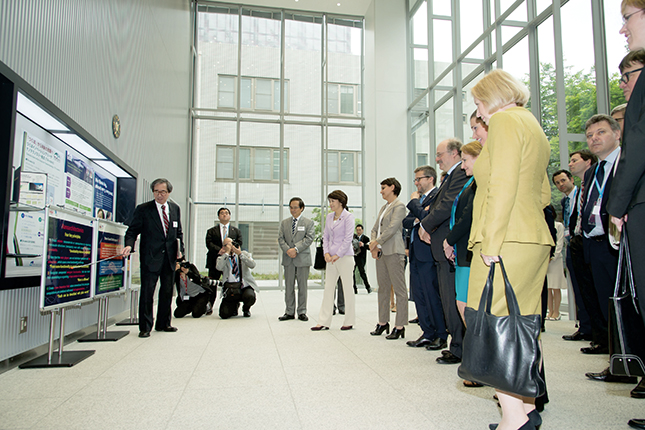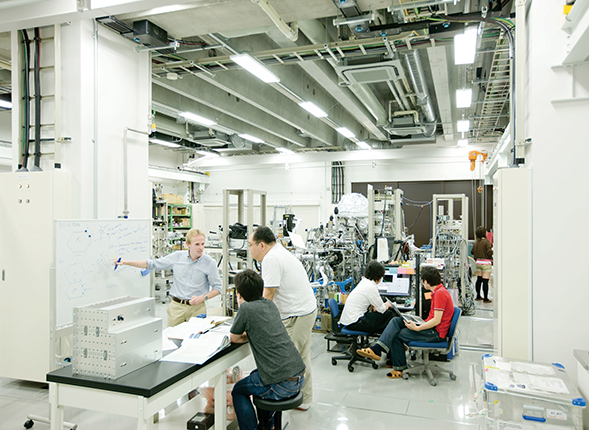Despite financial squeeze, Japan continues drive to globalize its science enterprise
DOI: 10.1063/PT.3.3423
The Japanese government will step in to help keep afloat the international research centers it began launching a decade ago, according to a 27 October announcement from the Ministry of Education, Culture, Sports, Science and Technology (MEXT). The centers, formed under the World Premier International Research Center Initiative, or WPI, aim to do top-notch science, bridge disciplines, globalize Japan’s research enterprise, and inspire reforms in the country’s academic and administrative cultures.
Under the WPI, MEXT kick-starts the centers, which are eventually supposed to become self-sustaining, similar to NSF’s Science and Technology Centers in the US. MEXT puts in $6 million to $12 million a year per center for salaries, travel, equipment, buildings, and other infrastructure, and for satellite sites inside and outside Japan. That funding is for 10 years, and centers can apply for an additional 5 years. They must also bring in matching funds. Five centers were created in 2007 (see Physics Today, December 2008, page 28
But the institutions that host the centers are finding it a challenge to fulfill their end of the WPI deal: taking over financially when MEXT funding expires. That uncertainty in funding has prompted discussions between the institutions and the ministry that resulted in the WPI Academy, a lower-cost approach to help preserve the WPI goals as centers mature. As Physics Today went to press, the organizational and financial details were still being ironed out.
Finding funding
In a 2015 assessment of the first batch of WPI centers, MEXT found them all to be highly successful. But it extended the funding of only one, the Kavli Institute for the Physics and Mathematics of the Universe (IPMU) at the University of Tokyo. Although hardly a surprise, given that funding was only guaranteed for 10 years, the impending end of the generous MEXT grants sent a chill through the four inaugural centers that didn’t win extensions and through the program as a whole.
Since the assessments nearly two years ago, the four centers that did not receive extensions have been seeking alternative sources of funding, needed by April. Motoko Kotani, director of the Advanced Institute for Materials Research (AIMR) at Tohoku University, says the university’s president has “promised to keep the core part of AIMR, but I as director make my best effort to find other sources to support international activities and young researchers.” Last July AIMR and the National Institute of Advanced Industrial Science and Technology (AIST) launched a joint laboratory to use mathematical modeling and computation to design new materials; AIST provided money to hire a dozen or so postdocs and a couple of associate professors, says Kotani. The lab’s goal, she says, is to develop new mathematical tools for analyzing complex materials and to transfer basic science to industry.
The International Center for Materials Nanoarchitectonics (MANA) in Tsukuba is the only WPI center based at a national lab rather than a university. When MANA’s startup funding ends this spring, its host, the National Institute for Materials Science (NIMS), will take it over as a “major research division,” says MANA director Masakazu Aono. The budget will be lower, he notes, and to compensate for hiring fewer postdocs, the center is strengthening collaborations with universities in Australia, Taiwan, and elsewhere. But, he says, having acquired state-of-the-art equipment and new buildings over the past decade, “MANA will be able to maintain its high activity.” He points in particular to the center’s work on nanosheets, atomic switches, and new nanoscale characterization methods.
The WPI centers that are still receiving their initial 10-year MEXT grants are, like AIMR and MANA, pinning their hopes for future support on collaborations with industry or government labs. At the University of Tsukuba, the International Institute for Integrative Sleep Medicine (WPI-IIIS) explores such questions as, Why do all animals with a relatively developed brain need to sleep? How is sleep regulated? The institute’s external funding exceeds MEXT money, says director Masashi Yanagisawa. He is optimistic that the institute can be supported by collaborations with the pharmaceutical industry, “where we make our own compounds, and companies provide some of the resources.”
About a year ago, the University of Tokyo’s president said he had raised half the money needed to sustain the Kavli IPMU. “I can breathe,” says director Hitoshi Murayama. Research highlights at the IPMU include insights into six-dimensional Calabi–Yau manifolds, dark matter, and the dynamics of new types of supernovae.
Ripple effects
One of the WPI’s missions is to reform Japan’s academic system. That means shifting from a traditional hierarchy to a more flexible system that encourages creativity, initiative, and mobility. “We want to take the better aspects of US departments,” says Yanagisawa. For example, Japanese university labs tend to have a rigid hierarchy from full professor down to graduate student. At Tsukuba’s WPI-IIIS, he says, “we have a nonhierarchical personnel structure.”
Center directors have discretion over hiring; in a break from tradition, salaries do not follow a set formula based on age and seniority, and directors can negotiate nimbly to make competitive offers. “We recruited someone who we are paying way beyond what the university president makes,” says Murayama. “It’s a great appointment. It shows the way forward.”
On average, 40% of WPI researchers are non-Japanese. The international makeup is roughly one-third each from Asia, Europe, and the US, with a sprinkling of researchers from Latin America and the Middle East. The character of each center is strongly influenced by its leadership—the IPMU’s five-year extension is contingent on Murayama staying on. (See the interview with Murayama in the 2013 story “Juggling dual-country careers
As for whether the WPI is having ripple effects, Murayama, Kotani, and others point to more foreigners on the faculties of their universities, more joint appointments with overseas institutions, and new programs that make it easier for overseas graduate students and more-senior researchers to adjust to Japan’s academic system. At the University of Tokyo, says Murayama, “salaries can now be adjusted by market.”
WPI Academy
In recent years Japan’s strapped economy has led to growing concerns about the host institutions taking over responsibility for the WPI centers when their 10-year MEXT grants wrap up. “The continual tightening of funding to universities in Japan and the weaker economic performance render it extremely difficult for universities to sustain WPI centers on their own,” says Akira Ukawa, deputy program director for the WPI and a scientist at the RIKEN Advanced Institute for Computational Science. Over the past decade, government support for university salaries has decreased by about 10%. And whereas competitive grants have become increasingly narrow and applications oriented, the WPI is looking to do basic research on longer time scales. Following the four 2015 extension denials, says Ukawa, “the big issue became how the four centers would continue.”
MEXT’s answer is the WPI Academy, an umbrella for graduated and current WPI centers. The academy has three aims, says MEXT’s Takuya Saito: uphold the elite WPI brand for the centers; serve as a forum for centers to share their experiences in science, globalization, and system reform; and act as a hub for global circulation of scientists.
MEXT has requested around $6 million to establish the WPI Academy next year, Saito says. If it comes through, it could provide some support to academy members. It would be a lot less than before, notes Murayama, “but it’s probably very important symbolically” and could help attract additional funds.
Based on what MEXT has learned from the WPI experience so far, the ministry is changing its requirements for new centers. First, proposals will have to take “a clear stance on human resource development,” says Saito. In the past, he explains, the emphasis has been on research, but future centers will need to include an education component. Second, the host institutions will have to spell out more clearly how they will build and sustain their centers after MEXT money runs out.
The MEXT move to establish the WPI Academy and the formation of new centers underscore the success of the WPI program, says Ukawa. “There is a strong feeling that cutting off support won’t do. The centers are a valuable long-term asset for science in Japan.”

Masakazu Aono (at board) hosted G7 and European Union science and technology ministers at the International Center for Materials Nanoarchitectonics in Tsukuba, Japan, in May 2016. One of the original facilities launched in 2007 under the World Premier International Research Center Initiative, the Tsukuba center is hosted by the National Institute for Materials Science.
OUTREACH TEAM, MANA


The Advanced Institute for Materials Research, one of Japan’s original World Premier International Research Center Initiative centers, marries math and materials research. Although the center has some funding lined up for when the initial government support runs out this spring, it continues to seek additional sources.
ADVANCED INSTITUTE FOR MATERIALS RESEARCH (AIMR), TOHOKU UNIVERSITY

More about the Authors
Toni Feder. tfeder@aip.org
